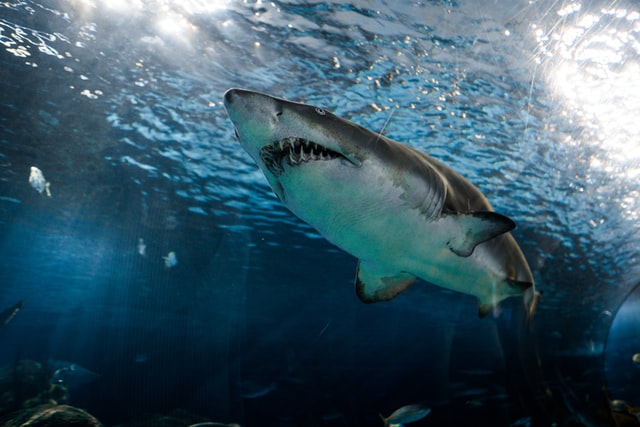Have you ever tried differentiating an animal’s sex? It is pretty common, especially for pet owners, vets, and those involved with animals, to do this process. Sexing helps prevent unwanted pregnancies as males and females of the same species are almost sure to mate. However, unlike typical household pets, there are animals out in the wild that require unique methods of identifying sex. One type of these animals is the marine life that we are all familiar with: the shark.
In this article, we will talk about sharks and how their sexes are differentiated. Sharks have subtle details in their bodies that can be seen if we observe them well enough. Knowing what to observe will be the key to determining their sexes. But first, we have to talk about one of the factors that make these characteristics obvious enough for us to see.

When Do Shark Reach Sexual Maturity?
It can be more challenging to try to differentiate sharks’ sexes when they are young, especially male sharks. We will talk about why this applies explicitly to male sharks later. Sexual maturity is the point where sharks are capable enough to mate and reproduce. In a nutshell, this is the minimum age at which the male shark is able to produce sperm, and the female is able to ovulate.
Each species of shark actually have different ages when they reach sexual maturity. However, the general age range for most sharks is 7-10 years of age. But that age range is not for all sharks, as the white shark species reach sexual maturity later at 12-18 years. The most well-known species, the great white shark, reach sexual maturity much later when they reach their late 20s.
Luckily, as broad as the age range may be, their physical characteristics are all the same, except for some species. Now, we will go over the physical characteristics that you should observe when attempting to determine a shark’s sex.
Physical Characteristics That Differentiate The Sharks’ Sexes

🦈Females Are Typically Larger Than Males
This is true for a lot of species. Females are mostly larger than males, but this difference cannot always be obvious. There are times when the size difference is small enough to make differentiating difficult. Sometimes looking at size alone is not enough to actually differentiate their sexes. This is especially true if you couldn’t see the shark physically and only through a photograph.
🦈Claspers For Males
In the males’ pelvic areas, you can locate a part called claspers. These pairs of slender, bone-like structures are actually mainly used for reproduction. For reference, the pelvic area is at the right past the shark’s belly. They are usually mistaken for being the shark’s penis, but this is not entirely true. The clasper is mainly formed through calcium deposits which grow more prominent as the shark gets older. This clasper formation is one of the reasons why their reproductive organs become more evident as they grow old.
Despite having two of the said organs, male sharks will only use one for mating. This organ is inserted into the female’s genital opening located in the cloaca. The main difference is that claspers are not present in females, but cloacas are available in both sexes.
🦈Females Only Possess Cloacas
Both males and females have cloacas, as they use this to get rid of digestive wastes. However, females also use it for mating, and the male’s sperm is inserted into this organ. The cloaca can be seen around the same pelvic area we previously mentioned, just right past the belly. The appearance appears to be an extra fin around the pelvic area.
Besides these organs, there are also marks around a female’s skin that can help you determine its sex.
🦈Bite Marks Can Also Help You Determine
When sharks start mating, the male tends to bite at the female. This somewhat aggressive ritual is normal for them, as it is a sign of courting. The bite will usually occur at the pectoral fin of the female shark. These fins are located on each underside of a shark, which has the purpose of steering the shark while swimming.
You can look at the pectoral fins for bite marks because chances are females will have them. However, this is a less common method for sexing sharks as they would need to have mated in the past. This can be harder for younger sharks or those who have not yet experienced mating. If you based on this alone can be pretty unreliable, especially if the bites could come from somewhere else. This is especially true for species of blue sharks, as females adapted to not developing bite scars or marks during mating.
Sharks are cannibalistic and would eat the same species for survival, which leads to fights and lots of bites. These bites can even impact the pectoral fin, which some people can confuse for the aftermath of mating. There is also the fact that not all mother sharks have bite marks due to a reason we will talk about later. So basically, the most reliable method is still checking if the shark has a clasper or not.
How Often Does A Shark Breed?
Sharks breed every two years, and some of the previously mentioned bite marks may or may not have healed yet. There are also times when adult sharks choose to breed at certain times of the year. This varies with every species, so it can be challenging to point out when breeding occurs for each shark. Shark mating is kind of hard to catch as it rarely happens, and there are only a few instances when people determine their consistency. Determining the breeding season of each shark can usually be determined by those living in areas where sharks are accustomed to.
That means it can be hard to wait for a breeding season when trying to see the differences between sharks’ sexes. It is a given that you males will bite females and that females will clearly be bigger once you know the process. However, a shark’s mating period can be hard to catch, mainly because this quick process happens so rarely.
Some Females Can Reproduce Without Males

Female Sharks can actually become impregnated without breeding with a male. It has been found that some species of sharks can asexually impregnate themselves and produce new offspring. This is a rare occurrence because sharks and mammals are not known to have the capacity to reproduce asexually. It may be due to an absence of males in the specific species of sharks.
However, asexual reproduction is not always the best when considering how the species will thrive. Genetic errors that can cause physical abnormalities and diseases can eventually spread much quicker in asexual reproduction. There is a lack of genetic diversity, and these negative traits can stack for each generation, causing the species to suffer.
This concerns a lot of researchers as it may lead to problems in the reproduction of these particular species of sharks. Considering that some species of sharks are already endangered, having this problem can affect their population on a much larger scale. Luckily, this has only been seen so far in some members of the hammerhead shark species.
This is what we meant when we previously mentioned that not all females that laid offspring would have bite marks. There may be rare instances where the female did not even mate to reproduce, to begin with. Who knows that in the near future, other sharks may develop the capacity to produce asexually as well.
How Is A Shark Born?
There are three methods of how a mother shark carries her offspring. This varies from the shark’s species.
🦈Ovoviviparous
Here, the mother carries the eggs inside her but is not directly connected to her. Once the eggs hatch, their food supply will basically be their unborn brothers and sisters. But eventually, their primary method of snacking will be feasting on each other. This somewhat brutal method of raising is normal for some sharks, and the survivors will usually just be 1-3 babies.
🦈Oviparous
The mother will lay the eggs externally, but not like how you expect other fishes to do so. The eggs are secured inside a leathery pouch known as a mermaid’s purse. This pouch contains the necessary nutrients that the offspring would need to hatch. However, the babies are not at all exposed to predators and other sharks as the mother shark guards them. They are also usually placed in secure areas where predators cannot easily reach them without bypassing the mother.
🦈Viviparous
This is a similar process to how mammals are being kept. The sharks will grow up as fetuses that will stay inside the mother while being attached through an umbilical cord. In the same manner as mammals, the baby sharks will then exit the mother’s body once they reach a certain age.
The period in which the sharks are developing varies with each species. But it typically takes a minimum of one year to a long wait of three years before they are born. During that time, there may be a tendency for sharks of the same litter to cannibalize each other. The mother will not interfere if that happens, as it is a survival tactic to see which offspring will thrive the most.
Other FAQs
🌟Can a shark change its sex?
Sharks are not usually popular to change sexes, unlike many other species of fish. These species are only known to transition from reproducing sexually to reproducing asexually. However, there is an exceptional case where a shark has been found to have both male and female organs. The shark was found to have claspers despite carrying offspring like a female shark.
🌟Why is a female shark almost always enormous than male shark?
Female sharks are basically built to be larger than males for the sole purpose of bearing offspring. Having babies would mean there needs to be more space inside the female’s body. That also means females are usually the more dominant type because of their superior size. However, it does not mean that a male shark of a larger species will be smaller than a female shark of other species.
🌟Why do some female sharks avoid males?
There are some instances where female sharks of the great white species are found to avoid males. Some female sharks are somewhat not fond of the brutal mating ritual that male sharks conduct. Extreme biting can usually heal and leave only a few marks, but it can get too aggressive. This may also be the reason why breeding seldomly occurs and why some females are restored to asexual reproduction. Regardless, the leading cause of these instances is the lack of exposure to males or their inability to locate male sharks.
🌟Do female sharks have thicker skin than males?
Female sharks actually have thicker skins that are almost twice as thick as those of males. The females have adapted to the biting in their mating ritual, which leads to them having much thicker skin. A shark’s skin is actually described to be as rough as sandpaper. You can only imagine how thick and rough a female shark’s skin is! However, this is still quite an unreliable factor when it comes to sexing sharks, as the difference is hard to spot.
🌟What does a young shark eat?
Younger sharks will usually eat krill, shrimps, and smaller fish. However, those who are younger will usually have to resort to eating the other unfertilized eggs of their own mother. Contrary to what many would have guessed, several species of sharks, including the whale shark, have their males grow faster than females. This is quite odd as females tend to grow in larger sizes during their maturity.
Bottom Line
Sharks are fascinating creatures that are unique from the animals we see every day. Their reputation for being a threat on local beaches often precedes them, in any case. However, it is interesting to examine the physical characteristics that set their two sexes apart from each other. These features may be subtle, but once you know what to look for, determining their sex becomes easier.
To have a better view under the water, you must know how to properly appreciate the aquatic life by clicking here.


